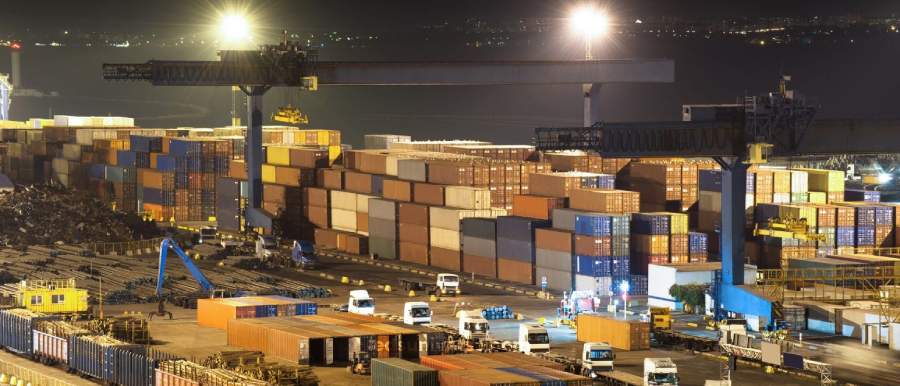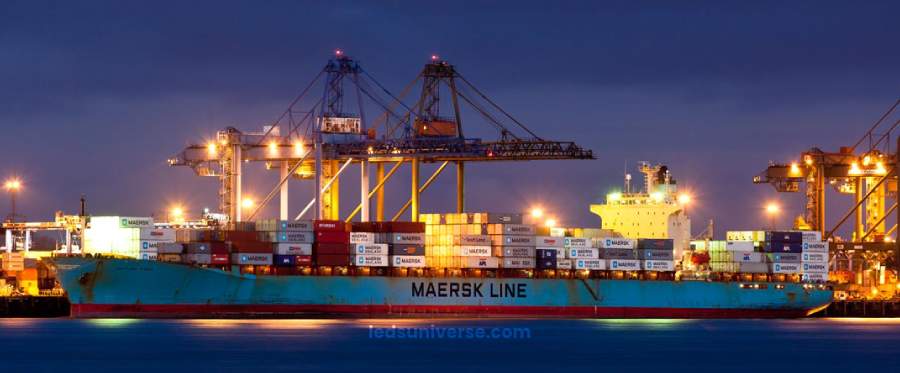As vessels arrive and depart, cargo is loaded and unloaded, and countless personnel work around the clock, reliable and efficient lighting is essential. With the rise of modern LED technologies, sea ports can now benefit from lighting solutions that provide brighter, more uniform illumination, while drastically reducing energy consumption and maintenance costs.
The vastness of port areas, exposure to harsh weather conditions, and the continuous flow of cargo and people demand robust, durable, and efficient lighting solutions. Sea port lighting systems must meet high standards to ensure optimal visibility while withstanding the environmental challenges of coastal locations.
Reach out for free lighting consultation
Table of Contents
ToggleIn sea ports, the primary concern is visibility. Given the continuous 24/7 operations, lighting needs to be strong, uniform, and energy-efficient. The lux levels in various port zones differ based on the activities taking place. For instance, cargo handling areas may require higher illumination compared to general walkways. Lux levels for sea port operations should generally range between 50 to 200 lux, depending on the task at hand.

In addition to brightness, the color temperature of lighting is crucial for sea ports. A range of 4000K to 6000K is typically recommended, as it provides bright, neutral white light, enhancing visibility in both day and night conditions. This range allows for better visibility and improved safety during operations, ensuring that port activities are not hindered by poor lighting.
Color rendering is another factor that impacts port operations. With a high Color Rendering Index (CRI), LED lights help distinguish colors more accurately, which is essential for ensuring that staff can work effectively under various conditions. This is especially important when identifying cargo labels, safety markers, or even individuals in the port area. A high CRI helps maintain the efficiency of operations by allowing workers to perceive the environment more accurately.
Uniformity in light distribution is essential in sea port lighting systems to avoid dark spots or poorly lit areas, which can be dangerous for both workers and vessels. Proper lighting distribution ensures that all areas of the port are equally illuminated, reducing the risk of accidents, particularly when handling heavy machinery or navigating vessels. Consistent lighting helps to maintain operational flow and minimizes the chances of errors during cargo handling or vessel movement.
Another critical requirement is controlling glare. Excessive glare can reduce operational efficiency, especially for drivers, crane operators, and other personnel handling critical tasks. LED lights with proper glare control measures ensure a safe environment by providing consistent illumination without blinding workers or compromising their vision. This is vital in high-traffic areas where the risk of accidents is elevated due to glare.

Ports are exposed to harsh environmental conditions, including saltwater, high winds, and heavy rains. Therefore, sea port lighting must be durable and weather-resistant. LED lighting systems are ideal for this purpose because they are designed to withstand these conditions without deteriorating. Seaport lighting must also be corrosion-resistant, given the constant exposure to salty air and moisture. High-quality materials, such as marine-grade aluminum or stainless steel, are commonly used in the construction of lighting fixtures to ensure longevity.
Temperature fluctuations can impact the performance of traditional lighting systems, but LEDs are capable of operating efficiently in a wide range of temperatures. Whether in extreme heat or freezing conditions, LED lights maintain their performance, making them suitable for ports in varying climates. Additionally, high humidity levels in coastal areas can damage electrical components, but sealed LED fixtures with IP65 or higher ratings ensure that the lights remain operational even in the most humid conditions.
Effective lighting placement in sea ports is a critical aspect of ensuring uniformity and visibility across the port’s vast spaces. Ports feature different zones with varying lighting needs, including high-activity loading docks, storage yards, vessel berths, and general walkways. Each of these zones requires carefully calculated placement of lights to ensure optimal coverage.
In areas like cargo handling zones, where large container ships are frequently moving, high-mast lighting is often employed. High masts, which can reach up to 40 meters or more, provide wide-area coverage, minimizing the number of poles needed while ensuring that shadows are reduced. This is essential for safety and operational efficiency, as it allows for better visibility in large, open spaces.
The height of the poles must also be considered in conjunction with the type of lighting being used. Taller poles require lights with greater lumen output to ensure sufficient brightness over a larger area. However, the lights should be positioned in a way that minimizes glare and avoids creating overly bright or dim zones. Uniform lighting is key to ensuring that workers can move safely, and ships can be maneuvered efficiently without the risk of dark spots or over-illuminated areas.
Lower pole lighting is often used in areas with specific tasks that require more focused lighting, such as near piers or maintenance zones. In these areas, precise lighting can help workers see clearly without the need for excessive brightness. Balancing the height and number of poles in a sea port is a technical task that should be done with careful planning, ensuring that all areas receive the appropriate level of illumination.
As sea ports are operational 24/7, energy efficiency is a critical factor in lighting design. Traditionally, ports used metal halide or high-pressure sodium lights, which consume large amounts of energy and generate significant heat. Modern LED lighting systems provide a solution to this problem by offering much lower energy consumption, longer life spans, and less maintenance.
LED lights can last for up to 80,000 hours, meaning that maintenance and replacement costs are significantly reduced. This is a major advantage in sea ports, where high maintenance costs and operational downtime can have significant impacts on productivity.
In addition, many modern LED systems come with energy-saving features such as motion sensors or dimming controls. These systems adjust the brightness based on the amount of activity in a particular area, ensuring that energy is not wasted in zones where little or no activity is taking place.
Safety and security are at the core of sea port lighting systems. Adequate lighting is crucial to avoid accidents, ensure smooth operations, and provide a secure environment for both workers and vessels. In the event of power outages or emergencies, ports need to have reliable backup lighting systems in place. LED emergency lighting systems are a practical solution due to their low energy consumption and reliability.
Moreover, integrating lighting with security systems such as CCTV cameras is essential for monitoring the port. LED lights with controlled brightness levels allow for better clarity in security footage, improving the effectiveness of surveillance systems in port areas. In zones requiring heightened security, such as restricted access areas or high-value cargo zones, motion-activated lights can also deter potential intruders.
Modern sea ports are increasingly adopting innovative lighting solutions to improve efficiency and reduce costs. Smart lighting systems that adjust according to real-time data, such as weather conditions or activity levels, are becoming more common. These systems allow for dynamic control over the intensity and placement of light, providing flexibility in managing the port’s lighting needs.
LED lighting is at the forefront of this shift. If you are worried about how to transition from traditional port lighting systems, modern LED technology offers a compelling solution. LED sea port lights are not only more energy-efficient but also boast a significantly longer lifespan, often lasting over 80,000 hours. This equates to nearly 10 years of continuous operation without needing significant maintenance, reducing both costs and downtime.
There are several reasons why sea ports should consider switching from traditional lighting systems to modern LED lighting:
In sea ports, where safety and security are paramount, lighting systems must be reliable and responsive. Traditional metal halide lights often take a long time to warm up and turn on after a power cycle. LED lights, however, turn on and off instantly, making it easier to respond to emergencies or sudden activity. This instant-on capability enhances the safety and security of port operations.
LED lights are much more energy-efficient than traditional lighting systems. Equipped with motion sensors, these lights can automatically dim or brighten based on movement or activity in a specific area. This not only ensures optimal lighting but also reduces energy consumption in areas with little or no activity.
LED lights provide superior illumination compared to metal halide lights. Their high CRI ensures that objects are rendered in vivid, accurate colors, making operations easier and safer, especially in critical areas such as loading docks or storage facilities.
The shift toward LED lighting offers significant benefits, from improved energy efficiency to reduced maintenance costs and enhanced lighting quality. By adopting modern lighting technologies, ports can not only meet the demanding requirements of 24/7 operations but also achieve long-term sustainability and cost savings. Whether you are considering upgrading to LED lighting or improving your current system, the advantages are clear: better visibility, lower costs, and a safer working environment.